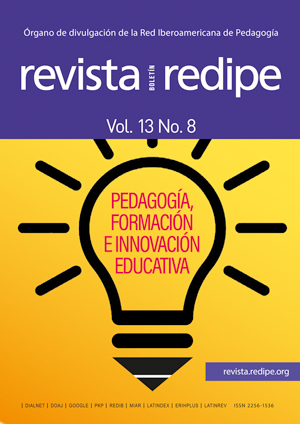Family Involvement in the treatment of language and communication in children with Autism Spectrum Disorder
Main Article Content
Keywords
Intervention, SAAC, TEA, communication skills
Abstract
The present study is a bibliographic review that aims to identify the contribution of the family in the development of communication skills and language of children with ASD between 0 to 6 years old. The question that guided the search was How does the family contribute to the improvement of communication and language in children from 0 to 6 years old with autism spectrum disorder? After an exhaustive review in the scientific literature about this subject, were selected 7 articles, in which it was evident that treatment with the participation of parents has reported significative advance in the development of communication and language. The active and committed participation of parents helped the improvement of the communication and language processes of their children. Children improved and produced more communicative acts, increased their lexical level and decreased repetitive and restricted patterns. Likewise, the parents had the opportunity to train in the application of strategies and techniques to replicate at home in order to maintain and generalize the learned behaviors in other contexts. On the other hand, the parents changed their communication style, acquired knowledge about the nature and impact of ASD and they were trained in the management of functional strategies to replicate them in the family environment. In conclusion, this systematic review research allowed us to identify the contribution of the family in the treatment of communication and language of children with ASD
References
Baixauli, I., Gastón, N., De Carlos, M., Colomer, C. (2018). Intervención en comunicación en el trastorno del espectro autista mediante el programa ‘More than Words’Estudio de caso. Neurol, 66 (1), 77-82. Neurología.com (neurologia.com)
Baña, C. (2015). El rol de la familia en la calidad de vida y la autodeterminación de las personas con trastorno del espectro autista. Ciencias Psicológicas, 9 (2), 324-336. file:///D:/Documents/Downloads/ adminojs,+Journal+manager,+623- 2426-1-CE.pdf
Cáceres, O. (Mayo de 2017). El uso del pictograma en el proceso de enseñanzaaprendizaje del niño con autismo. [Tesis doctoral, Universidad de Las Palmas de Gran Canaria]. https://docer.com.ar/doc/nn0158c
Fortea, M., Escandell, M., Castro, J., Martos, J. (2015). Desarrollo temprano del lenguaje enniños pequeños con trastorno del espectro autista mediante el uso de sistemas alternativos. Neurol, 60 (Supl 1), 31-35. www.neurologia.com
Garrido, D., Carballo, G.; Franco, V.; GarcíaRetamero, R. (2015). Dificultades de Comprensión de lenguaje en niños no verbales con trastorno del espectro autista y sus implicaciones en la vida familiar. Neurol, 60(5), 207-2014. https://www.neurologia.com/articulo/2014226
Lampert, M. P. (septiembre de 2018). Trastorno del Espectro Autista. Epidemiología, aspectos psicosociales, y políticas de apoyo en Chile, España y Reino Unido. Chile: Asesoría Técnica Parlamentaria. https://obtienearchivo.bcn.cl/ obtienearchivo?id=repositorio/ 10221/25819/1/BCN Politicas_de_apoyo_al_espectro_ autista_FINAL.pdf
Martínez, M., López, R., Padilla, D., Góngora, M., Pérez, F. (2008). Abordaje psicofamiliar en las alteraciones del lenguaje de niños con trastorno del espectro autista. International Journal of Developmental and Educational Psychology, 3(1), 99- 105. https://www.redalyc.org/articulo. oa?id=349832318010
Moore, D., Baggett, K., Barger, B. (2021). Measuring parent positive support of social communication among toddlers with autism: a systematic review. Psychosocial Intervención, 30, (1), 57- 66. https://www.redalyc.org/articulo. oa?id=179865420006
Sánchez, M., Martínez, E., Moriana, E. (2015). La atención temprana en los trastornos del espectro autista (TEA). De los Psicólogos de la Educación, 21(1), 55- 63.
https://www.redalyc.org/articulo. oa?id=613765434008
Sanz, P., Fernández, M., Pastor, G., Tárraga, R. (2018). Efectividad de las intervenciones basadas en metodología TEACCH en el trastorno del espectro autista: Un estudio de revisión. Papeles del Psicólogo, 39 (1). https://www.redalyc.org/articulo. oa?id=77854690005
Silva, A., Barboza, A., Miguel, C., Barros, R. (2019). Evaluating the Efficacy of a Parent- Implemented Autism Intervention Program in Northern Brazil. Trends in Psychology, 27, (2), 523-532. https://www.redalyc.org/articulo. oa?id=539660190016
Soto, R. (2007). Comunicación y lenguaje en personas que se ubican dentro del espectro autista. Electrónica publicada por el Instituto de Investigación en Educación, 7, (2), 1- 16. https://www.redalyc.org/articulo. oa?id=44770212
Toboada, X. (2018). Efecto de la intervención psicomotriz con participación del cuidador sobre la comunicación gestual de una niña con autismo. Med Hered, 30, 100-104. DOI: https://doi.org/10.20453/rmh. v30i2.3549



